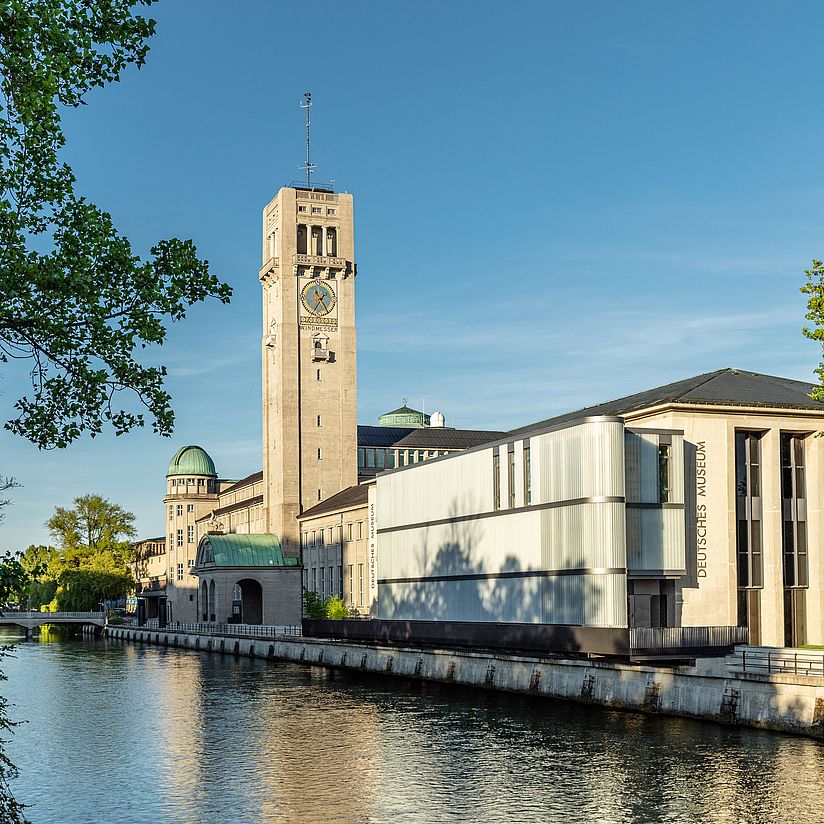
Photo: (c) Alexander Goettert | Deutsches Museum
Who we are
The Deutsches Museum – embracing the future
Offering millions of visitors an up-close, hands-on experience of science and technology.
The Deutsches Museum in Munich is one of the largest, most important and most traditional natural science and technology museums in the world. It has around 1.5 million visitors every year. On currently about 40,000 square meters of exhibition space at five different locations, there are a good 30 exhibitions to see, showing a huge thematic range: from Atomic Physics to Aeronautics, from Chemistry to Bridges and Hydraulic Engineering, from Musical Instruments to Health.
Visitors come to the Deutsches Museum to see a unique collection: from the first gasoline-powered car, printing presses and engines to the great airplanes. They come because scientific relationships are explained here so simply that even children can understand them. They come to see unique demonstrations - such as the model railway, the microscopy theater or the chemistry shows - or to experience the rotation of the earth live at Foucault’s pendulum.
The Deutsches Museum exists since 1903. The museum’s founding father, Oskar von Miller, wanted to create a place where a general overview of science and technology could be given - including playful approaches that would allow visitors to grasp interrelationships with the help of demonstrations and experiments. In 1925, his dream came true: the exhibition building on Museum Island as we know it today was opened.
But the Deutsches Museum is much more than this exhibition building. It consists of five locations, each of which is a highlight in its own right: The Transport Center (Verkehrszentrum) displays more than 275 historic cars, trains, bicycles and much more on the subject of mobility - from the Benz Patent-Motorcar to ICE trains. Flugwerft Schleißheim houses a large part of the Deutsches Museum’s aviation collection and displays more than 70 aircraft - from Lilienthal gliders to Eurofighters. The Deutsches Museum in Bonn is the first museum for contemporary research and technology in Germany and is currently being expanded into a central experience site for artificial intelligence. And the Deutsches Museum in Nuremberg is all about the future - and how visions become innovations.
And the Deutsches Museum is much more than an exhibition space. After all, the purpose of a museum is not only to exhibit, but also to preserve cultural assets. The museum’s collections include more than 125,000 exhibits - of which just about 25,000 are normally on display, and around 1,000 objects are added year after year. The museum also houses Germany’s largest museum library, with nearly one million volumes. With almost five shelf kilometers, the archive of the Deutsches Museum is the leading special archive on the history of science and technology. Then there are the museum’s workshops, where unique dioramas and demonstrations are created and exhibits are restored. Finally, the Deutsches Museum’s research institute and educational programs also play a major role in imparting knowledge. All in all: The Deutsches Museum is already much more than just a museum.
But the institution is far from reaching its goal. As part of the Deutsches Museum’s future initiative, we want to become the most modern museum on earth. The first stage of this project of the century called “RA1” (Realisierungsabschnitt 1) has already been completed. The first part of the exhibition building on Munich’s Museum Island has been renovated and brought up to the state of the art. Here we are now showing 20 completely redesigned or updated permanent exhibitions. Parallel to this, modernisation is now underway in the second half of the building and the development of the complex at Ludwigsbrücke into the Forum of the Future.
After all, science and technology are subject to constant change - as are the ways in which knowledge is communicated. In the 21st century, we want to continue to make knowledge exciting and compelling to experience. And we want to make the museum a place where society negotiates its future, where people can exchange ideas about what kind of progress they want to see and what tasks science and technology must fulfill to achieve this. In addition, we want to use many digital formats to make the Deutsches Museum’s collection globally visible and use new forms of communication to enter into dialog with people all over the world.
The Deutsches Museum in facts and figures
- Founded 1903
- Cornerstone laid 1906
- Exhibition building on the Museumsinsel opens 1925
- Library on the Museumsinsel opens 1932
- Congress Hall on the Museumsinsel opens 1935
- Flugwerft Schleissheim opens 1992
- Deutsches Museum Bonn opens 1995
- Transport Museum (Verkehrszentrum) opens 2003
- Deutsches Museum Nuremberg opens 2021
- RA1 with 20 new exhibitions on the Museumsinsel opens 2022
- The Forum of the Future opens 2022
Legal form: Public-law institution, financed mainly by the Bavarian state government and the German federal government, member of the Leibniz Association
Number of objects in the collection: More than 125,000
Exhibition space
- Museumsinsel 45,000 square metres (currently: 20,000)
- Verkehrszentrum 12,000 square metres
- Flugwerft 7,500 square metres
- Deutsches Museum Bonn 1,400 square metres
- Deutsches Museum Nuremberg 2,900 square metres
- Total 68,800 square metres
Number of volumes in the library 991,000
Kilometres of shelf space in the archives 4.7
Number of staff 554 (effective: 04/2025)
